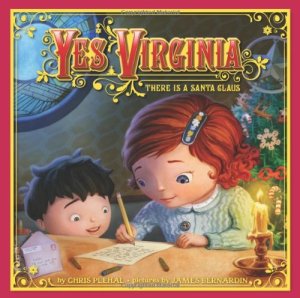[fusion_builder_container hundred_percent=”yes” overflow=”visible”][fusion_builder_row][fusion_builder_column type=”1_1″ background_position=”left top” background_color=”” border_size=”” border_color=”” border_style=”solid” spacing=”yes” background_image=”” background_repeat=”no-repeat” padding=”” margin_top=”0px” margin_bottom=”0px” class=”” id=”” animation_type=”” animation_speed=”0.3″ animation_direction=”left” hide_on_mobile=”no” center_content=”no” min_height=”none”]
The holiday season can be stressful for some children. When your students come from a background that isn’t as wealthy as other students, they can be left without hope. I’ve often had students tell me that Santa doesn’t come to their house and therefore cannot be real. I choose to take the “Yes, Virginia” stance when the topic of Santa comes up.
If you haven’t read the letter or seen the movie about Virginia, you should. It airs on TV every December. It is a story about a girl who doubts the existence of Santa and is able to reconcile her belief through a letter to the editor of a newspaper. The movie is based on a true story. I’ve always felt that this letter holds some truth when it talks about the existence of Santa. The editor who replied to Virginia, talked about how Santa exists because of generosity of love. When my students ask me if I believe, I tell them yes. I go on to explain that Santa exists because of love and generosity. He lives through our actions when we are generous and show that we love each other. I’ll have my students brainstorm when they were recently generous or showed love.
This doesn’t work for every student, not all students are Christian who celebrate Christmas. In this case, I use this as a lesson in tolerance. I have every student share about their winter holiday that is celebrated in their household. It leads to a discussion about how we all celebrate different things in our different cultures, and that is ok. The winter season can be an excellent opportunity to teach tolerance if you’re willing to have the conversation.
I’ve also had students who no matter what you say insist that Santa is not real. I usually pull these students aside and ask them not to discourage others even they themselves do not believe. Even then, I still feel that I need to say “Yes” when students ask. I want my students to understand that love and generosity do exist. I also want my students to have something to hope for. In today’s society we are often bombarded with negative images. I hope that by me saying “yes”, that I can give my students some sense of hope. Hope can be a powerful thing, and I would hate to see such young people lose hope at such an early age.
With all of this being said, before making any decisions about how to answer this question, any teacher needs to know their class before answering. You might choose to answer differently depending on age and/or belief systems held in your student population. No matter what your belief system, I hope that all teachers can find hope, generosity and love during this winter season.
[/fusion_builder_column][/fusion_builder_row][/fusion_builder_container]


